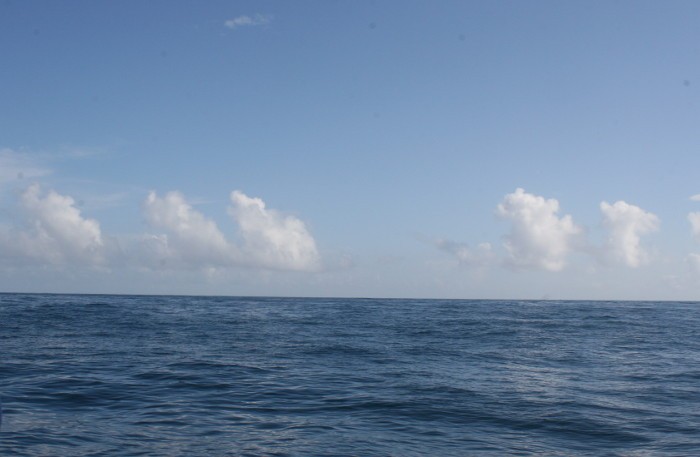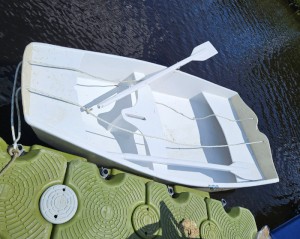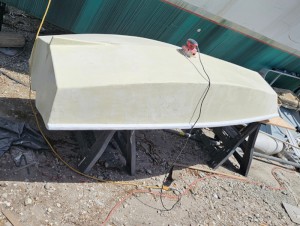Kaimusailing
s/v Kaimu Wharram Catamaran
| Vessel Name: | Kaimu |
| Vessel Make/Model: | Wharram Custom |
| Hailing Port: | Norwalk, CT |
| Crew: | Andy and the Kaimu Crew |
| About: | Sailors in the Baltimore, Annapolis, DC area. |
23 April 2024 | St Marys, GA
D4 Launchie
The laptop pooped the bed, so I have to scurry around with alternatives. Not as bad as typing on the phone.
17 April 2024 | St Marys, GA
Dinghy Skeg
I was suffering with what seemed like a cold and also had allergy symptoms. I awoke and felt fine. The green pollen that was coating everything was gone. Maybe it will return.
07 April 2024 | St. Marys, GA
Clammy Hands
Items came in from TEMU, the Chinese cut rate retailer. One was a nice little drone that cost about twelve and a half dollars. It looked like an easy thing to play with while I coughed and sneezed. I was fighting a summer cold, even though it is not summer elsewhere, it seems like it here. A nice [...]
02 April 2024 | St. Marys, GA
Sun Doggie
After laminating the cedar strips onto the gunwales of the dinghy I found the screws I used wouldn’t come out. The epoxy had seized them. The screw heads were stripped so I cut a straight slot in the heads with the cut off wheel. The cedar smoked when the screw heads got red hot. I could remove [...]
21 March 2024 | St. Marys, GA
Just Add Water
The rainy weekend started off with overcast and fog but no rain. It looked like I might be able to get something done on the D4 dinghy. I wanted to change the bow seat which is really the bow deck. The sailing option uses the deck to hold the freestanding mast. I didn’t like how the deck looked, [...]
01 March 2024 | St. Marys, GA
D4 Dinghy Alternative Seats
The rain event was more wind than rain, strong winds with gusts up to 44 mph. We drove into town to see what the harbor was like. There was a small sailboat that had dragged anchor and was sitting close to shore. The tide was out. We left and played with Bleu at Notter’s Pond.
Jacksonville Entrance

.
It was now my watch again, so I took pictures of the sunrise and adjusted course to keep the jib drawing. The main was still furled. The wind died away to nothing. On this boat the furling line comes aft on the port side and runs through a turning block that has a built in spring loaded cam cleat. It is impossible to let out the furling line without holding the cam cleat in the open position. The cam cleat is on the port rail and the jib sheets lead aft over the cabin top, one sheet to each aft corner of the cabin top. On this boat there is only one winch on each side of the boat and a bunch of rope clutches to retain the halyard, sheets, etc. This makes singlehanding difficult. Say we want to roll out the jib on a port tack. The furling line won’t release unless we hold the cam cleat open. We are at the port rail adjacent to the helm station and the sheet winch is on the other side of the boat up on the cabin top. What I did to roll out the jib was to pull a bunch of the furling line through the cam cleat while holding it open with the other hand, then go to the other side of the boat and begin pulling the sail out and sheeting in.
.
In order to roll up the jib on the furler, the cam cleat lets the line pass that way without interfering, but you have to maintain tension on one of the sheets to make a nice tight furl. The starboard sheet on the other side of the boat goes through a block between the rope clutch and the winch. You can bring the sheet all the way over to the port side and manage both the furling line and the sheet at the same time. The furling line can be lead up from the rail to the port sheet winch and although it is not a perfectly fair lead, it works. Handling the jib for a starboard tack is a lot easier, since the winch and furling line are on the same side of the boat.
.
On this particular boat the main traveler car is practically immobile. When we wanted to let it out, it didn’t move. But that’s not the only problem with the main. On this boat is a Doyle main, a nice sail, and a Doyle stack pack sail cover to stow the main sail. A stack pack uses stiff battens to hold both sides of the sail cover up like a trough for the sail to drop in. The battens are held up by lazy jacks, a spider web of line on either side of the main, and the fully battened main drops right into the stack pack. The problem is when hoisting the main, the aft ends of the sail battens catch on the lazy jack lines. It is very tedious to wait for the movement of the boat so that the mainsail can rise without getting snagged. Each sail batten has a chance to catch on the aft 3 jack lines. Once they get past that the sail goes up without much trouble, except this boat seems to need lubrication of the batten cars and the sail track. It was a lot of work hoisting the sail.
.
The stack pack zips up, very neat, except it is up above the boom, the boom is up above the cabin top, and the end of the boom goes aft past the cabin top, past the flimsy bimini (kind of like a convertible top, but for a boat cockpit), and the unfortunate soul who is either zipping up or unzipping has to climb up there and deal with the main boom which is banging back and forth if there is any sea state. The bimini has two hard tracks that can be stepped onto, but they are very narrow, and the bimini is a very light aluminum tubing structure that wiggles underfoot.
.
The stack pack zipper is so far aft that it is nearly impossible to grab it. Also, in order to get it to zip, the very end of the zipper has to be held so that the zipper teeth can line up straight. Working up there while the boat dances around in rough water is an experience that generates nautical epithets.
.
The correct way to install the stack pack zipper is to secure both ends of the zipper, usually the aft end is secured to the topping lift line near the end of the boom. The forward end is attached to the mast. The zipper can now be zipped with a light endless string lead through small blocks at either end of the zipper. When you pull on the line anywhere, it will pull the zipper toward the little blocks.
.
Using a single winch for main halyard, main sheet, jib sheet, and reefing lines A and B can come back to bite you when you need to adjust more than one line. On a boat that is trying to maneuver quickly, like when you are racing or in a small harbor and have to quickly reef and adjust the sails, the single winch, which saves the boat manufacturer a lot of money, is a stumbling block for the sailor.
.
The skipper commented that the boat was physically beating him up and I agreed. It has been a lot of work doing ordinary sailing procedures that on other boats follow more traditional layouts of equipment. This is a very popular boat, so I guess the paying customer must just go along with the layout and adapt.
.
On this particular boat the GPS doesn’t communicate with the VHF radio or the autopilot. On older electronic units this is common, but new gear such as this boat’s should be properly installed and integrated. On this boat the radar was useless and the original chartplotter had a badly damaged screen so that it was unusable. Perhaps the interfaces were for this unit and not the new chartplotter in the cockpit.
.
We were trying out the recently purchased CF-C1 laptop with a cheap U-blox GPS dongle and its display and functionality were preferable to the Garmin chartplotter. I did not bring the Getac, which would offer bright daylight viewing. The CF-C1 is difficult to see in cockpit in sunlight.
.
The handheld VHF radio that Carpenter Ron gave me works better than the VHS radio installed in this boat’s nav station! The reception of the NOAA weather information is important to our planning and the little handheld outperformed the permanent installed radio. The permanent radio is a Raymarine with DSC, which requires NMEA GPS data, and the handheld is an old (now) Standard Horizon HX751.
.
We did not have enough fuel to power our way into the headwind that was building. We could only go as far as Jacksonville by running one engine at a time. The Lagoon 380 comes with 26 gallons of diesel fuel tankage for each engine. The fuel consumption depends on how hard the engine is run. The lowest figure I found was .6 gallons/hour. Running into a headwind will of course use more.
.
The skipper intervened. We had 4 5 gallon jugs of diesel that we could add to the fuel tanks. He calculated how much fuel we may have used in the starboard engine, which was the lowest on fuel. Based on the fuel gauge, which I interpolated at 3/8 of a tank, we would need just under 15 gallons to top off that tank. The fuel fill was located on the “sugar scoop” stern where the steps to climb down to go swimming are. It would be dangerous to go down there and try to pour from a heavy diesel jug into that fuel fill. It was at an angle, very awkward. Skipper clipped onto his harness and the lifeline stanchion, poured into a funnel I was holding over the fuel fill. Now I understand how a boat can be found floating with no one on it. Maybe they were trying to fill a fuel tank out on the sugar scoop.
.
It ended up taking 3 jugs, more than I thought, and the decision was, do we start pouring in the fourth jug to see how much fuel was actually used in that engine, or do we save that jug for an emergency that might come up later. We saved it. Soon we were underway running both engines at 2500 and speeding along just under hull speed at 6 1/2 knots. Jacksonville sea buoy was 107 miles ahead.
.
The sea was flat, almost no wind. The forecast was for SE 5-10 increasing to 15 and clocking South. The weather system was coming from the South, so after we got fuel we would be slogging down the East coast of Florida, either offshore, or in the ICW.
.
We coordinated so that the skipper would be on watch when we came into port in the morning. He was familiar with the channel and I had never seen it. He would be on watch from 10 PM to 2 AM and I would take the 2 AM to 6 AM and also be standing the 6 PM to 10 PM the evening before. I planned to make breakfast after I got off watch. I would of course be tired.
.
We ran down the line to the sea buoy at Jacksonville. It was no longer stormy, indeed there was almost no wind. The only wind was the air coming over the deck due to our motion, motoring. After standing the evening watch I fell asleep. My cell phone was dead and I use that as an alarm clock, so I left the compartment light on in my bunk. The skipper could wake me for my watch without having to search in the dark. Several times I woke up, thinking I was sleeping in the cabin on the settee. Why was he turning the lights on in the cabin? Then I remembered and fell back to sleep.
.
I was very groggy when the skipper said, “You’re on”. Fatigue from the get go. Keep awake somehow. Walk around on deck. I did get some energy from seeing the chartplotter count down the miles to the waypoint at the sea buoy. I didn’t make breakfast after getting off watch. I crashed out in the bunk, dog tired. I never got to see the Jacksonville entrance.
.
We motored up the ICW from the St. John’s River to Jacksonville Beach. I made super egg toasties with bacon for breakfast. We tied up at Beach Marine and fueled up, taking note of how much fuel we had to replace in each tank. The calculation was that we were burning about a half a gallon of diesel per engine per hour. We then shifted the boat into a slip near the gas dock. It was a very tricky maneuver and I complimented the skipper, “It’s evident that you were a race driver”, which he was.
.
After all the lines, fenders, and calling around for local services, we were quite tired. My phone was dead, but somehow it had recharged enough to send a text to Capn Neil of Catnapper, an old friend that was living aboard in Jacksonville Beach. To my surprise he was in Beach Marina and took us out to lunch at a good restaurant. We watched some auto racing on one of the flat screens, it was also a sports bar.
.
Thunderstorms came through and we will hunker down till tomorrow. The image is the calm after the storm, taken the day before sailing into Jacksonville.






